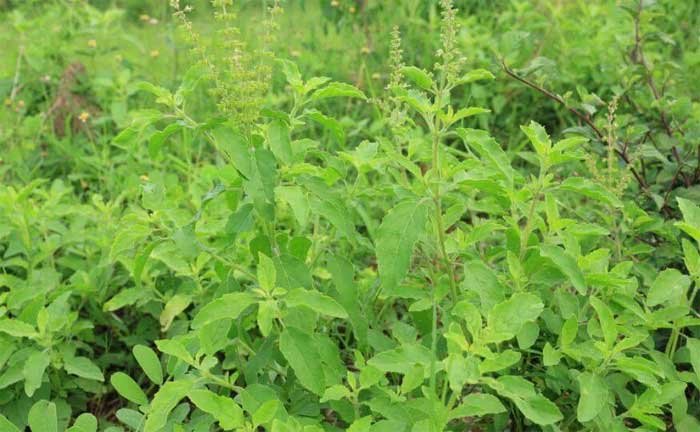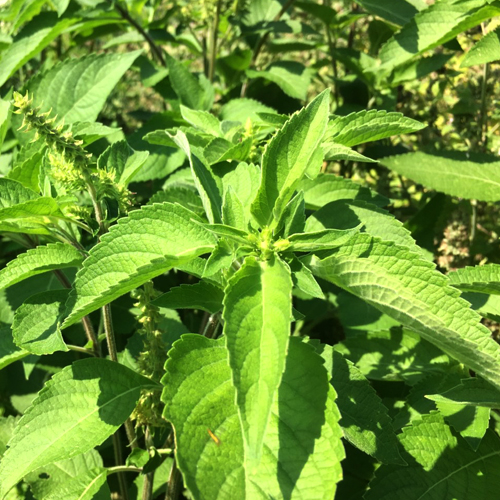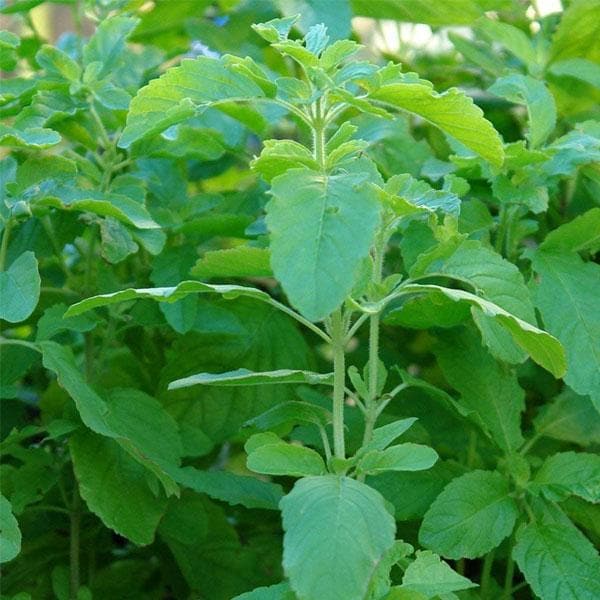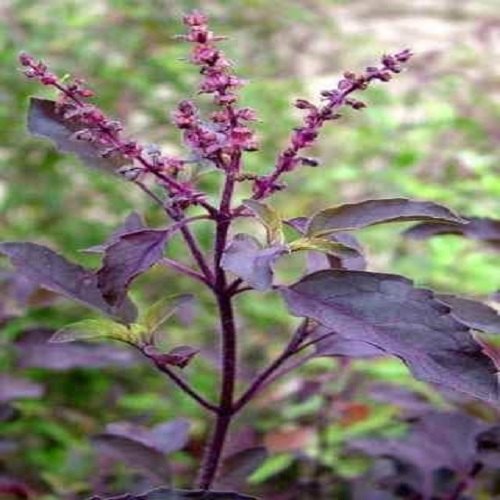The herb basil is a botanist’s dream. Basil grows better as you chop it! Tulsi has been used to purify and protect against bad luck for thousands of years, and it’s still cultivated in Indian temples and courtyards today.
Tulsi is not just a plant, it has multiple benefits. In india, tulsi is used as medicine, it is worshipped by people and is used in multiple things. And the best part is, you need not to put extra efforts to plant a tulsi plant, except some care and that too in winter seasons.
It’s a surprisingly simple plant to cultivate for all the advantages it can offer.
Tulsi Plant Types
Vana Tulsi – (Ocimum gratissimum)
Vana Tulsi leaves are dark at the base but lighten up higher on the plant, which has made them a favorite of many. This kind is lemony in flavor and different from other peppery-tasting relatives.
Vana Tulsi seeds are difficult to come by, but the unusual flavor and distinct appearance make them well worth seeking.
Rama Tulsi – (Ocimum sanctum)
Tulsi is a perennial plant of the mint family that’s been grown in India since the Middle Ages. It has broad, light green leaves and purple blooms known as Rama Tulsi.
Rama Tulsi plant is a fragrant variety that has a clove-like aroma.
Krishna Tulsi – (Ocimum tenuiflorum)
The peppery Krishna Tulsi, also known as “Purple Leaf Tulsi,” is a perennial herb cultivated in many regions of India. The dark purple leaves and a pungent fragrance distinguish it from other holy basil plants. The plant’s spicy tastes are amplified by this slow growth.
Know about tulsi vastu direction while bringing or growing it home.
How to Grow Tulsi Plant?
Tulsi, like all other basils, is a simple to grow a plant. It thrives in warm climates as a shrub but must be planted again each year in cooler zones; it will die if temperatures drop below freezing.
Tulsi Plant Propagation
Plant the cutting in a tiny pot full of moist, new potting soil. Set the pot in a warm, bright location out of direct sunlight. A kitchen countertop is an excellent spot. Water the cuttings regularly to ensure that the soil does not get dry, and new shoots should appear in 4 to 6 weeks.
Sowing Tulsi Seeds
You may sow the seeds as soon as late spring when the temperature averages 70 degrees Fahrenheit. If you want to start them earlier, start them indoors.
Dampen the soil and press the tulsi seeds firmly into it. Make sure you use good, all-purpose compost if you’re planting the seeds in pots or seed trays. Spray mist bottle watering is recommended for this step. Use a sprinkling can or spray gun instead of a watering can because the water flow will be too strong and may wash the seeds away.
Cover the seeds with a cloche if you’ve planted them outside. Not only will this protect the seeds from the elements and animals, but it will also keep the heat in, speeding up germination. If you’re sowing seeds indoors, a propagation chamber might be of help.
Keep the soil damp. You should be able to see young seedlings after 2 weeks.
Have a look at the types of money plants and money plant benefits you should know about.
Repotting
Repotting your holy basil in pots is necessary if you want to grow it in containers. Some people repot theirs every spring, while others allow the plant to stay in its container until it grows too big or becomes pot-bound.
You should repot a plant using a clean, new pot that is somewhat larger than the current one. Planting a seedling in an excessively big container can induce shock and death.
The roots of more mature plants might become tightly entangled, forming a “root ball.” If this is the case, use your fingers to gently release them.
Finally, add fresh potting mix or all-purpose compost to the container. The roots of your tulsi plant should sit just below the lip of the container when it’s planted inside.
Planting Out
All basil types appreciate a rich soil environment, so if you’re planting in the ground, keep that in mind. To increase air circulation, dig up the dirt thoroughly before planting. For additional air circulation a month before planting, add well-rotted organic compost or dung to the soil.
Make a hole that is somewhat larger and deeper than the current container. Fill the hole with good all-purpose compost. Allow plenty of time for watering since it must be very moist at this point. If you’re growing more than one plant, allow 18 inches between them at this stage.
Also read about spider plant benefits here
Tulsi Plant Care
When your seedlings are three inches tall, place coarse mason sand 2 inches deep around them in the ground. This sand mulch prevents weeds, maintains moisture, and controls temperature swings.
Tulsi plants require regular watering. Try not to get water on the leaves since damp leaves can promote mold and disease development. It is discovered that watering early in the morning allows for greater leaf drying time outside before temperatures drop.
This herb prefers temperatures that seldom drop below 50°F. Tulsi may be grown outside all year round in regions that never experience a freeze. Because tulsi isn’t a large plant, it can also be cultivated as a year-round houseplant.
Tulsi Plant Benefits
- Tulsi is a wonderful host plant for butterflies. As it blooms, the nectar attracts beautiful winged creatures, such as bees and swallowtail butterflies.
- The herb contains many essential oils that are antibacterial, antiviral, and antimicrobial in nature.
- You can either make tulsi tea or add it directly to your foods-it tastes great!
- Finally, remember that your tulsi plant will be producing more leaves than it can use. This means you’ll have an abundance of Tulsi to share with friends and family.
- Read a bit about snake plant benefits as well here before bringing it home
Uses Of Tulsi Plant
Some of the most common uses of tulsi plant include:
- Making tea and using it as a natural remedy for various illnesses. The leaves and essential oils of tulsi have antibacterial, antiviral, and antimicrobial properties, making it an effective treatment for a wide range of conditions.
- Adding fresh or dried tulsi leaves to food as a seasoning or garnish. The leaves have a mild peppery flavor that pairs well with many different cuisines and dishes.
Conclusion
Tulsi is a hardy herb that requires little care to thrive. To keep your plant in optimal condition, be sure to provide ample sunlight and water, as well as a regular fertilizing schedule. With these simple tips, you will enjoy lush and bountiful tulsi plants for many years!
You should also read about areca palm care and its benefits here.



I feel Tulsi plants are not just great because of Vastu but also for the benefits it offers. It is considered auspicious and is known as the “Queen of Herbs”. Your article provides really good information that I was searching for a long time. There is always something new to learn from your blogs.
Never knew apart from medication purposes, it has such amazing types, too!